Contents
Is your hair falling out more than usual? You’re not alone. Many women and others face hair loss, like thinning or patchy spots. Losing 50-100 strands a day is normal, but more can be worrying. What causes hair loss, and how can you stop it?
Female pattern hair loss (androgenetic alopecia) is common, affecting up to 30 million women in the U.S. It shows as thinning on the top of the head. Other types include bald spots or losing a lot of hair due to treatments like chemotherapy.
There are many ways to treat hair loss in women. Options include minoxidil, lasers, pills, plasma therapy, and microneedling. With the right treatment, you can grow your hair back and feel confident again.
Key Takeaways
- Hair loss is a common issue affecting millions of women and people of other genders
- Female pattern hair loss (androgenetic alopecia) is the most common cause of hair loss in women
- Hair loss may present as thinning hair, bald spots, handfuls of hair loss, or full loss due to medical treatments
- There are many effective hair loss treatments for women, including topical minoxidil and prescription medications
- With the right diagnosis and treatment plan, hair loss can be managed and hair regrowth is possible
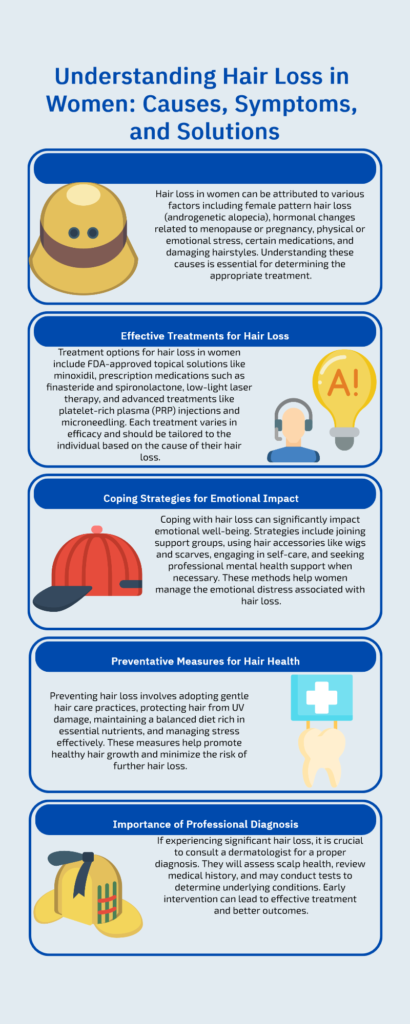
The Life Cycle of Hair
To understand hair loss in women, we need to know the hair growth cycle. Our hair goes through three main phases: anagen, catagen, and telogen. Each phase is important for hair health and growth. Problems in these phases can cause hair to fall out or thin.
Anagen Phase
The anagen phase is the growth phase, lasting 2 to 8 years. About 90% of our hair is in this phase. Hair grows half an inch each month, or 6 inches a year. Things like genes, age, and health can change how long this phase lasts and growth speed.
Catagen Phase
After anagen, hair enters the catagen phase, lasting 2 to 3 weeks. This phase makes follicles shrink and slows growth. About 3% of our hair is in catagen at a time. It’s a step in the cycle that gets follicles ready for the next phase.
Telogen Phase
The telogen phase is the last stage, lasting 2 to 4 months. Around 6% to 8% of our hair is resting in this phase. Hair doesn’t grow but stays in the follicle until it falls out. Losing 50 to 100 strands a day is normal and part of the cycle.
Things like not getting enough nutrients, hormonal issues, or stress can mess with the cycle. This can make more hair enter the telogen phase too soon, leading to more shedding and thinning. Knowing the hair growth cycle helps us find and fix the causes of hair loss in women.
| Phase | Duration | Percentage of Hair |
|---|---|---|
| Anagen (Growth) | 2-8 years | 90% |
| Catagen (Transition) | 2-3 weeks | 3% |
| Telogen (Resting) | 2-4 months | 6-8% |
Common Causes of Hair Loss in Women
Hair loss in women can come from many things, some lasting, some not. Losing 50 to 100 hairs a day is normal. But losing more can make you feel bad about yourself. We’ll look at common causes and how to deal with them.
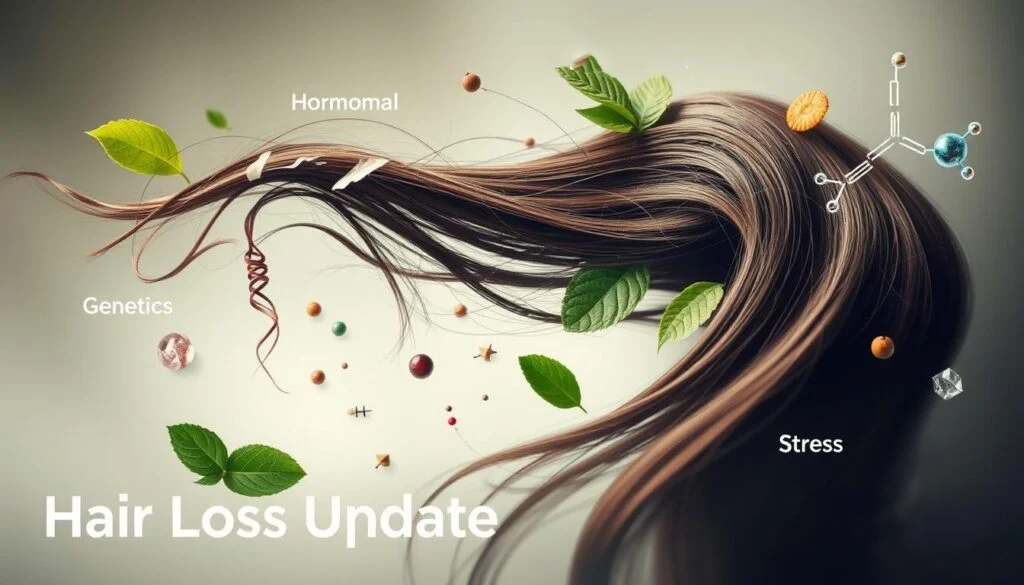
Telogen Effluvium
Telogen effluvium is a type of hair loss that happens when many hair follicles stop growing early. It can be caused by:
- Physical or emotional stress
- Hormonal changes (e.g., after having a baby or during menopause)
- Lack of important nutrients (like iron or vitamin D)
- Some medicines or treatments (like chemotherapy)
This kind of hair loss usually goes away in a few months. But, fixing the cause and living healthily can help your hair grow back.
Female Pattern Hair Loss (FPHL)
Female pattern hair loss, or androgenetic alopecia, is a genetic issue. It makes hair thin over time, especially at the crown and part line. It can start at any age but gets more common after menopause. Hormonal changes, like in PCOS, can also cause it because of too many androgens. To treat it, you can use minoxidil, laser therapy, or medicines like finasteride or spironolactone.
Hormonal Changes and Medical Conditions
Hormonal changes and some health issues can make hair loss worse. Some common ones are:
- Thyroid problems (too little or too much thyroid hormone)
- Autoimmune diseases (like alopecia areata or lupus)
- Changes during menopause
- Changes during pregnancy and after having a baby
Fixing the health issue or hormonal problem is key to getting your hair to grow back. Working with a doctor can help find the cause and plan treatment.
Medications and Supplements
Some medicines and supplements can cause hair loss. Here are some examples:
- Chemotherapy drugs for cancer
- Blood thinners (anticoagulants)
- Medicines for depression or anxiety
- Too much vitamin A or selenium supplements
If you think a medicine or supplement is making you lose hair, talk to your doctor. They can suggest other options or change your treatment plan. In many cases, hair loss from medicines stops when you stop taking them.
Hairstyles and Treatments
Some hairstyles and treatments can cause hair loss. This is because they pull or damage the hair follicles. Traction alopecia, from tight hairstyles like ponytails, is one example. Harsh chemicals like bleach or perms can also weaken hair and cause loss. To avoid hair loss, be gentle with your hair and avoid tight styles. Use deep conditioning and protective styles to keep your hair healthy. For more advice, check out HairLossUpdate.com.
Reasons for Hair Loss in Women, Treatment of Hair Loss in Women
For women, losing hair can be upsetting and puzzling. It’s important to know the reasons and treatments for hair loss. Common causes include genetics, hormonal changes, medical issues, some medicines, and harsh hairstyles.

Androgenetic alopecia, or female pattern hair loss, affects up to 50% of women. It often starts in a woman’s 40s, 50s, or 60s. Women with polycystic ovary syndrome (PCOS) are more likely to lose hair this way.
Other reasons for hair loss are telogen effluvium and anagen effluvium. Telogen effluvium makes you lose 300 to 500 hairs daily. Anagen effluvium causes fast hair loss from treatments like chemotherapy. Frontal fibrosing alopecia affects postmenopausal women, while central centrifugal cicatricial alopecia can come from certain hair products or styles.
There are many ways to treat hair loss. Topical minoxidil is FDA-approved and can help hair grow back. It might take 4 to 6 months to see results. Low-light lasers can also make hair thicker and fuller, with some people getting mild scalp irritation.
I was devastated when I started losing my hair, but after discussing my options with a dermatologist, I felt more hopeful. I’ve been using minoxidil consistently for the past few months, and I’m already seeing some improvement in my hair’s thickness.
Prescription drugs like finasteride and spironolactone can help too. They fix hormonal imbalances that might cause hair loss. Newer treatments like platelet-rich plasma and microneedling help by making more collagen and improving blood flow to the hair roots.
| Treatment | Description | Typical Results Timeline |
|---|---|---|
| Topical Minoxidil | FDA-approved treatment that stimulates hair growth | 4-6 months of regular use |
| Low-Light Lasers | Increases hair density and diameter | Several months of consistent use |
| Prescription Medications | Address hormonal imbalances contributing to hair loss | Varies based on medication and individual response |
| Platelet-Rich Plasma | Injections that stimulate hair growth by promoting collagen production | Several months to a year for full results |
| Microneedling | Stimulates hair growth by improving blood flow to hair follicles | Several months of consistent treatments |
The best treatment for hair loss depends on the cause and what you prefer. A dermatologist can help pick the right treatment for you. This way, you can feel confident and have healthier, fuller hair again.
Symptoms of Hair Loss in Women
Hair loss in women can show up in many ways. The signs can change based on the cause. Knowing the symptoms helps women find the right treatment. Let’s look at common signs of hair loss in women.
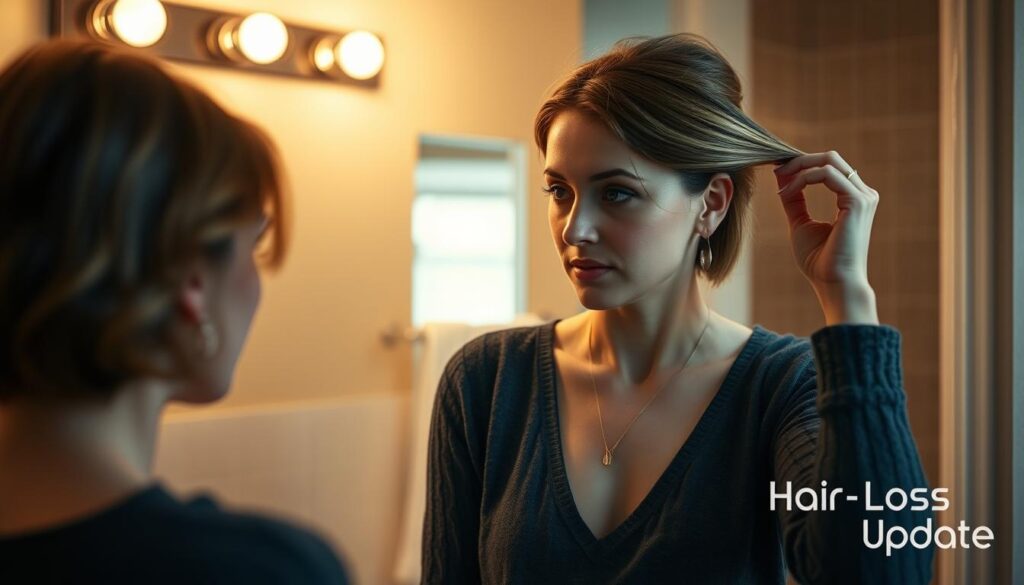
Gradual Thinning on Top of Head
One common sign is gradual thinning on top of the head. This is often called female pattern hair loss (FPHL). It makes the part wider and hair less dense. Women first notice it at the part and on the top of their head.
Over time, the scalp shows more as hair gets finer and less dense.
Circular or Patchy Bald Spots
Women may also see circular or patchy bald spots. This is called alopecia areata. It’s an autoimmune disorder that causes hair loss in round patches on the scalp. These patches might grow together, making bigger bald areas.
Sometimes, hair falls out on other parts like eyebrows, eyelashes, or the beard too.
Sudden Loosening of Hair
Some women see hair falling out suddenly, especially after a shock. This is called telogen effluvium. It happens when many hair follicles enter a resting phase too soon. This can make a lot of hair fall out when brushing or washing.
This shedding is usually temporary and stops in a few months.
Full-Body Hair Loss
Women might lose hair all over due to treatments like chemotherapy. This hair loss is often temporary. Hair may grow back, but it might look or feel different.
Patches of Scaling on the Scalp
Scaly patches on the scalp can mean ringworm or other infections. These infections can cause hair loss if not treated. Treating the infection can help hair grow back.
| Symptom | Description |
|---|---|
| Gradual Thinning on Top of Head | Widening of the part and decrease in hair volume, most noticeable where hair is parted and on the top-central portion of the head |
| Circular or Patchy Bald Spots | Sudden appearance of one or more circular bald patches on the scalp, which may overlap to create larger areas of baldness |
| Sudden Loosening of Hair | Large amounts of hair falling out when combing or washing, often triggered by physical or emotional shock |
| Full-Body Hair Loss | Loss of hair all over the body, typically a side effect of medical treatments such as chemotherapy |
| Patches of Scaling on the Scalp | Scaly patches on the scalp accompanied by inflammation, redness, and itching, which may indicate ringworm or other scalp infections |
If you see any of these signs, see a healthcare professional. They can find the cause and help you treat it. Early action can stop more hair loss and help hair grow back.
Diagnosing Hair Loss in Women
If you’re losing hair, see a dermatologist for a correct diagnosis. They are experts in diagnosing hair loss in women. They will check your scalp, look at your health history, and might order blood tests. These tests help find conditions that could be causing your hair loss.
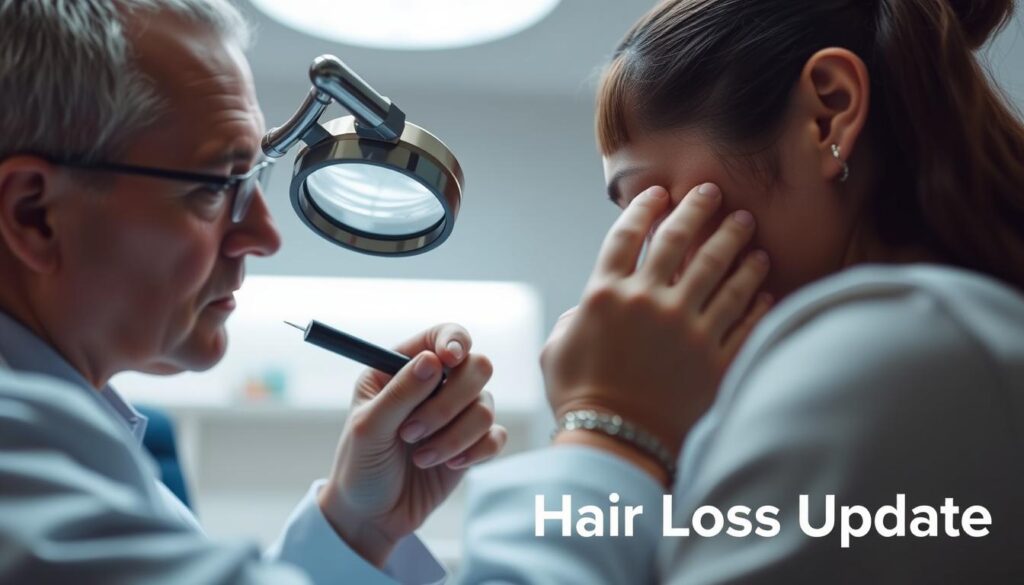
Your dermatologist will likely do a hair pull test during your visit. This test pulls on a small hair section to see how many strands come out. If more than six strands fall out, it shows you’re losing hair. This could mean you have different types of hair loss, like:
- Telogen effluvium
- Anagen effluvium
- Loose anagen syndrome
- Early androgenetic alopecia
- Advanced alopecia areata
Your dermatologist might suggest blood tests for iron levels, thyroid issues, or hormonal problems. Low iron levels, especially in women who menstruate, people with anemia, or vegetarians, can cause hair loss. Thyroid problems, like hyperthyroidism or hypothyroidism, can also lead to hair loss due to hormonal changes. Blood tests can show if your thyroid hormone levels are off.
Women with thin hair and no bald spots might have too much androgen. This can cause hair loss, hair growth in odd places, irregular periods, and acne. Blood tests can show if androgen levels are too high.
In some cases, a scalp biopsy is needed to find out why you’re losing hair. This means taking a small skin sample from your scalp for a closer look under a microscope.
| Diagnostic Tool | Purpose |
|---|---|
| Scalp examination | Check the scalp and hair follicles’ condition |
| Hair pull test | See how much hair you’re losing and shedding |
| Blood tests | Look for conditions like iron deficiency, thyroid issues, and hormonal imbalances |
| Scalp biopsy | Look at skin samples under a microscope to find hair loss causes |
Working with your dermatologist and sharing details about your hair loss helps get an accurate diagnosis. This leads to a treatment plan made just for you.
Hair Loss Treatments for Women
As a woman facing hair loss, I know it’s tough to find good treatments. Luckily, there are many hair regrowth treatments out there. These include FDA-approved options, off-label drugs, and new therapies. Let’s look at some top choices.
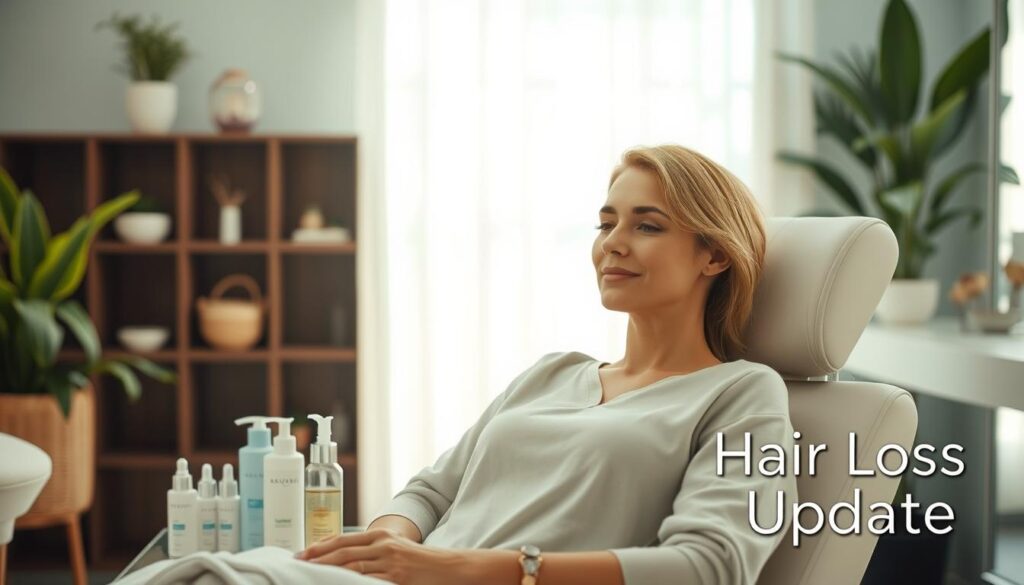
Topical Minoxidil
Minoxidil is a treatment approved by the FDA for women with hair loss. It comes in 2% and 5% strengths. You put it on your scalp to help hair grow back. Studies from 2018 found it works well for androgenetic alopecia, a common type of hair loss.
Low-Light Lasers
Low-light laser combs and caps use soft light to wake up hair follicles. Some have been approved by the FDA. A 2018 study showed they work better with minoxidil. People using them were happier with their hair growth.
Prescription Oral Medications
There are also prescription drugs that might help with hair loss in women. These include:
- Finasteride: This was made for a big prostate but can slow down hair loss and help new hair grow.
- Spironolactone: This drug blocks androgen receptors, which can lessen hair loss.
- Ketoconazole shampoo: This shampoo fights fungus but might also lower testosterone that causes hair loss.
Platelet-Rich Plasma
PRP therapy uses your own blood to help your scalp grow hair. A 2019 review said it can cut down on hair loss and make hair thicker and fuller.
PRP therapy has shown promising results for many of my patients struggling with hair loss. It’s a safe, non-surgical option that uses the body’s own healing powers to help hair grow.
Microneedling
Microneedling makes tiny holes in the scalp to help minoxidil work better. It makes hair thicker and fuller. A 2016 study found scalp massage, like microneedling, makes hair thicker.
| Treatment | Effectiveness | Considerations |
|---|---|---|
| Minoxidil | High satisfaction rate among users | Available over-the-counter |
| Low-Light Lasers | Improves hair recovery when used with minoxidil | Some devices are FDA-approved |
| Prescription Oral Medications | May slow hair loss and promote new growth | Off-label use; requires doctor’s supervision |
| PRP Therapy | Reduces hair loss, increases density and diameter | Non-surgical; uses patient’s own blood |
| Microneedling | Enhances absorption of topical treatments | Stimulates scalp; may improve hair thickness |
Choosing the best hair loss treatment depends on why you’re losing hair and what you need. Always talk to a healthcare professional to find the right treatment for you.
Coping with Hair Loss as a Woman
As a woman facing hair loss, I’ve seen how it can hurt your self-esteem. It’s tough, but there are ways to deal with it and find support. Hair loss hits millions of women in the U.S., with up to 30 million facing it. Remember, you’re not alone in this fight.
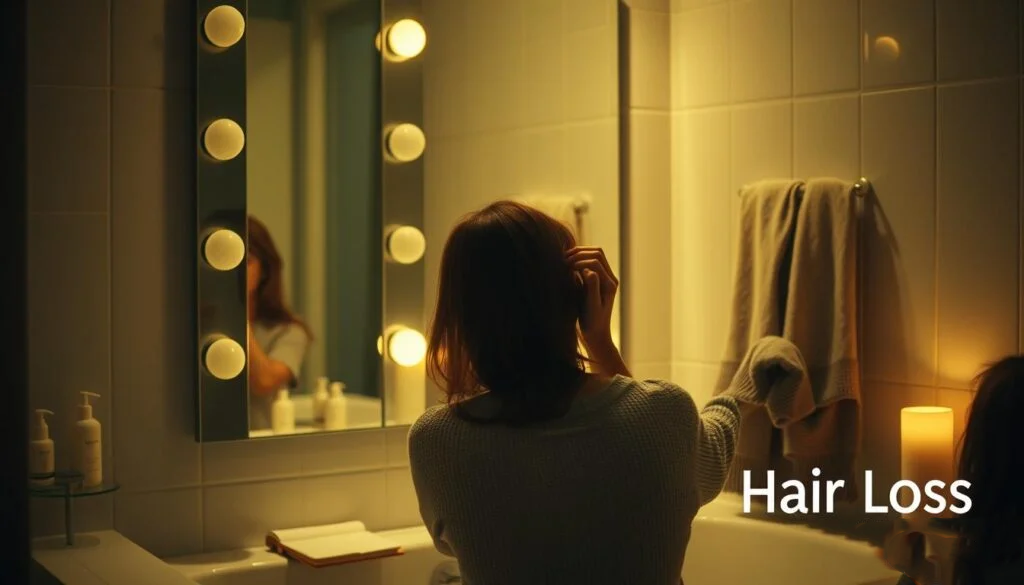
Joining a support group has been a big help for me. Meeting other women who get what you’re going through is comforting. We share our stories, give advice, and support each other. It’s a place where you can talk openly without fear.
Using hair accessories like scarves, hats, or wigs can also boost your confidence. They help hide thinning hair and make you feel better in public. Trying out different styles and colors is a fun way to express yourself and feel more in charge of how you look.
“I never realized how much my hair was a part of my identity until I started losing it. Wearing a wig has helped me feel more like myself again.” – Sarah, 42
Looking into hair replacement options like toppers or extensions can offer a quick fix while you wait for other treatments. Remember, most hair loss treatments take a long time, sometimes up to a year or more. It’s okay to feel frustrated, but be kind to yourself and focus on taking care of you.
| Coping Strategy | Benefits |
|---|---|
| Joining a support group | Connecting with others, sharing experiences, and receiving emotional support |
| Using hair accessories | Concealing thinning hair, boosting confidence, and expressing personal style |
| Trying hair replacement options | Providing a temporary solution while exploring long-term treatments |
| Focusing on self-care | Promoting overall well-being and resilience during the hair loss journey |
Most women learn to accept their hair loss and move on. But some might need help from mental health experts if it’s really affecting them. There’s no shame in asking for help when you need it. Your mental health and well-being are the most important things.
Dealing with hair loss is a personal journey. What works for one person might not work for another. Be patient, kind to yourself, and open to trying different things until you find what makes you feel good. With time, support, and self-love, you can get through this tough time and come out stronger.
Preventing Hair Loss in Women
Hair loss can be tough on women, but there are steps to help. By using gentle hair care practices, protecting your hair, eating well, and managing stress, you can keep your hair healthy. This helps your hair grow naturally and stay healthy.
Be Gentle with Your Hair
Treat your hair with care to prevent hair loss. Avoid tight hairstyles like high ponytails and braids. These can pull on your hair and cause hair loss. Use a wide-toothed comb and be gentle when brushing your hair.
Also, use heat styling tools less often. When you do use them, apply a heat protectant and keep the temperature low.
Protect Your Hair from UV Light
UV light can damage your hair, just like your skin. Protect your hair from the sun, especially in summer or if you’re outside a lot. Wear a hat or scarf to cover your hair, or use hair products with UV filters.
Maintain a Healthy Diet
What you eat affects your hair health. Eat a balanced diet full of important nutrients. Include protein, biotin, iron, and vitamins A, C, and E in your meals. Add fruits, veggies, lean proteins, and whole grains to your diet.
If you think you’re not getting enough nutrients, talk to your doctor about supplements.
“I’ve found that making small changes to my diet, like adding more leafy greens and lean proteins, has made a noticeable difference in the thickness and shine of my hair.” – Sarah, 42
Manage Stress Levels
Stress can cause hair loss by affecting the hair growth cycle. To reduce stress-related hair loss, try these methods:
- Regular exercise, such as yoga, walking, or swimming
- Meditation or deep breathing exercises
- Engaging in hobbies or activities you enjoy
- Getting enough sleep each night
- Seeking support from friends, family, or a therapist when needed
| Prevention Tip | How It Helps |
|---|---|
| Gentle hair care practices | Reduces breakage and traction alopecia |
| Sun protection for hair | Minimizes UV damage to hair |
| Balanced diet rich in nutrients | Supports healthy hair growth and prevents deficiencies |
| Stress management techniques | Reduces the risk of stress-related hair loss |
Use these tips daily to keep your hair healthy and prevent hair loss. If you’re losing hair and it won’t stop, see a healthcare professional. They can find out why and help you with treatment.
When to See a Doctor for Hair Loss
As a woman, I know how much hair loss can affect us. It’s important to get medical advice if you have hair loss worries. If you see sudden or a lot of hair falling out, or if you have bald spots or scalp irritation, see a dermatologist. This can help find health issues early and start treatment.
If you’re losing hair, don’t wait to see a doctor. They will check you over, look at your health history, and might do tests to find out why you’re losing hair. They could check your blood for things like hormonal problems, nutrient shortages, or autoimmune diseases.
Getting advice from a doctor about hair loss can make you feel better and help you take steps to keep your hair healthy.
Your dermatologist might do a scalp biopsy to check for scarring alopecia or other skin issues that can cause hair loss. Then, they can suggest the best treatments. These could be:
- Topical medications like minoxidil
- Oral medications such as finasteride or spironolactone
- Low-level laser therapy
- Platelet-rich plasma injections
- Microneedling
Your doctor can also tell you how to prevent more hair loss. They might suggest gentle hair care, protecting your hair from the sun, eating well, and managing stress.
| Reason to See a Doctor | Potential Cause | Treatment Options |
|---|---|---|
| Sudden or excessive hair loss | Telogen effluvium, alopecia areata, hormonal changes | Medication, lifestyle changes, scalp treatments |
| Patchy baldness or scalp irritation | Alopecia areata, fungal infections, psoriasis | Corticosteroids, antifungals, light therapy |
| Gradual thinning on top of the head | Female pattern hair loss | Minoxidil, finasteride, low-level laser therapy |
Remember, talking about hair loss can be tough, but it’s important for your health. Seeing your dermatologist regularly can help you keep an eye on your hair health. With the right advice and treatment, you can work towards having a full, healthy head of hair.
Conclusion
Many women face hair loss at some point in their lives. Over 50% of women have some hair loss by age 79. This number goes up with age, from 12% at 20-29 to over 50% at 80 and older.
It’s important to see a doctor if you’re losing hair. They can find out why, from hormonal issues to medical conditions and lifestyle. There are many treatments out there for hair loss.
These include things like minoxidil, finasteride, and spironolactone. There’s also laser therapy, PRP therapy, and hair transplantation. A dermatologist or trichologist can help make a plan just for you.
Dealing with hair loss can also affect your feelings. Joining support groups or talking to loved ones can help. Seeing a mental health expert is also a good idea.
By focusing on hair health, eating well, and managing stress, you can stop more hair loss. This helps hair grow back healthier.
You’re not alone in this fight. With the right mix of knowledge, medical advice, treatments, and support, you can get your hair back. Keep learning and taking care of yourself for the hair you want.
FAQ
What is the most common type of hair loss in women?
Female pattern hair loss, also known as androgenetic alopecia, is the most common type. It affects up to 30 million women in the U.S. This condition causes thinning on the top and sides of the head over time.
What causes sudden hair loss in women?
Sudden hair loss can happen due to telogen effluvium. This is triggered by stress, childbirth, crash diets, iron or vitamin D deficiency, or psychological stress. It usually starts a few months after the event.
Can hormonal changes lead to hair loss in women?
Yes, hormonal changes can cause hair loss. After menopause, female pattern hair loss (FPHL) becomes more common due to lower estrogen levels. Polycystic ovarian syndrome (PCOS) can also cause FPHL because of too many androgens.
What are the treatment options for hair loss in women?
Women can try topical minoxidil, low-light lasers, or prescription medications like finasteride and spironolactone. Platelet-rich plasma injections and microneedling are also options. A dermatologist can help pick the best treatment.
How can I prevent hair loss as a woman?
To prevent hair loss, be gentle with your hair and avoid tight hairstyles and harsh treatments. Protect your hair from UV light. Eat well and manage stress to keep your hair healthy.
When should I see a doctor about my hair loss?
See a doctor if your hair loss is sudden, patchy, or has other symptoms like scalp irritation or fatigue. Early help can stop more hair loss and help regrowth.
Can hair loss be a sign of an underlying health condition?
Yes, hair loss can show an underlying health issue, like thyroid problems, autoimmune disorders, or nutritional deficiencies. A dermatologist can find the cause and suggest treatment.
How can I cope with the emotional impact of hair loss?
Joining a support group or talking to a therapist can help with the emotional side of hair loss. Using scarves, hats, or wigs can also boost confidence. Hair replacement options like toppers or extensions can make you feel better about your look.
